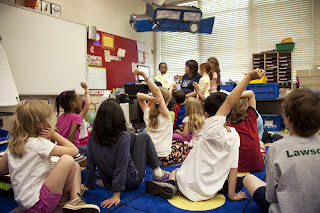(Guest Post: Jeffrey A. Meyer is a Radio Amateur and Model Railroader, and Retiree currently residing in Painesville, Ohio.)SARCNET opens up the average classroom to an entirely new way to offer, conduct, coordinate and teach classroom STEM topics. They have accumulated fun, relevant, and practical lesson plans to teach elementary school-aged kids STEM topics for grades 3-6.
If your school doesn’t have something like this, your kids are really missing out. You also need to know that there are less than fifty programs like this in elementary schools nationally.
First and most importantly, I’m not here to tell you how to manage your classroom or how to practice your craft. You are the professionals, it’s your territory and you deserve both the praise and the respect that goes along with that level of responsibility.
TEACH ALONE OR AS A TEAM?
What I am proposing is that you don’t always have to do all the teaching alone. By approaching some teaching opportunities as a team, the employed teacher doesn’t have to be the subject matter expert, so the “other half” of the team could actually be recruited from hobbyists in Amateur Radio, Model Railroading, etc., as well as aviation and a host of other interesting STEM relevant professions.
Now take this tag-team approach and designate the non-teacher to be a local Amateur Radio hobbyist. The Radio Amateur would bring the needed practical side of the hobby, i.e. radio science, electronics, kit and antenna building, propagation, communication skills, project management, decision making, etc.
This collaborative approach, coupled by using a hobby (Amateur Radio), to explain and supplement classroom learning, is exactly what we are talking about. This is SARCNET.
HISTORY
SARCNET started back in 2015 when an elementary school librarian noticed some kids weren’t interested in playing kickball at lunchtime and thought these kids may be more interested in doing something else. Being a Radio Amateur herself, she brought her radio in, introduced it to the kids and SARCNET was born. What started out as an easy lunchtime diversion, has now expanded to six schools and two countries with a host of lesson plans and activities that are pure genius.
The kids learn Morse Code, radio communication protocols, assemble electronic kits, talk to the entire world, seamlessly learn geography, build solar and microcontrollers to both monitor power output and control plant growth, build antennas, search for sources of radio interference, locate hidden transmitters (aka “Fox Hunts”), manually track satellites, etc…..
The kids love it, the parents support it and the principal (Michael Day, St. Kevin’s Primary School, Ormond, Victoria, Australia) had the following to say about it:
“It is interesting that in this day and age of mobile broadband networks and social media that Amateur Radio, the pioneering radio hobby of the last century, would be an excellent way of introducing science and technology to young children today. Amateur Radio enthusiasts are an amazing, untapped resource for educators. They are hidden away in every community and can provide their own equipment and expertise. They also have a zeal to pass on this technology to the next generation. So this largely free and enriching collaboration, between the schools and the Amateur Radio fraternity, is a classic win-win situation.
When I first introduced the school Amateur Radio club at St. Kevin's Primary School in Ormond Victoria, I had no idea what a success it would be. We were lucky to have an Amateur Radio enthusiast within our ranks, so the introduction was initially driven by this staff member. The teachers, parents, and students are now raving about it. To see the children confidently building electronic kits or talking to other schools over shortwave radio is quite incredible. I am now exploring ways to expand this program. The following article, by Julie and Joe Gonzales, (our staff member and her husband) introduces the modern world of Amateur Radio. It explains how they set up Amateur Radio clubs at three primary schools in Melbourne and it provides all the information needed for other schools to get involved.“
ANOTHER ELEMENTARY SCHOOL USING AMATEUR RADIO IN THEIR STEM CURRICULUM
Now let’s turn to W. B. Beam Intermediate School in Cherryville, NC, and what they started in 2021. One of the school’s 4th-grade teachers there, Mark Reep, is also a Radio Amateur and he set up an Amateur Radio Club. I personally spoke to him in February of 2022 and with a total school enrollment of 200 students, he already has 77 of them actively participating in it, right now. That’s nearly forty percent of the total enrollment!
Why are these programs so popular? Plainly speaking, the kids find the topics interesting, relevant, valuable, and most of all, fun. As a teacher, this is possible anywhere in the U.S. and why not in your school?
As a teacher, using a team approach can reduce your stress, better connect you to your community, is likely to be FREE of charge, and offers a win-win-win for everyone involved. By partnering with any hobbyist or other relevant occupational professional, it’s a win for you, a win for the volunteer, and most of all, a larger life-changing win for your kids.
After all, it does take a Village and both hobbyists and professionals are just waiting for the chance to help you and make a real difference for the kids.
Your Fellow Villager,
Jeffrey Meyer
Painesville, OH
Photo by
CDC on
Unsplash

























